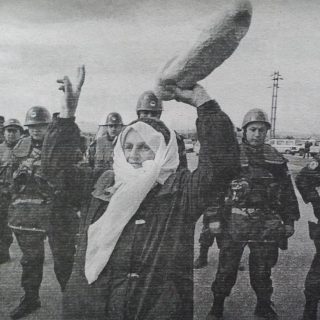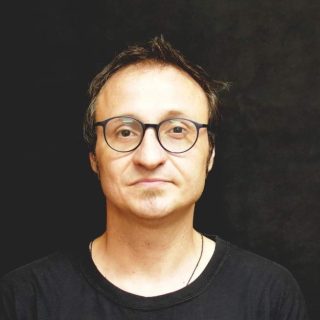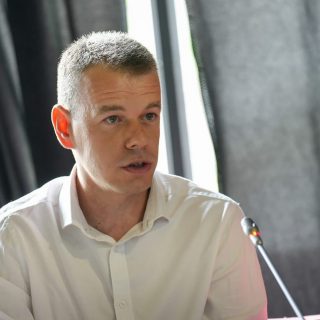Philosopher Emil Cioran gives a special status to music in our being-in-the-world. He, with a masterful lucidity, affirms that “we carry in us all the music that we have not heard in our life, which lies in the bottom part of the abyss of memory. All that is musical in us is memory. When we had no name, we must have heard everything.”[1] What this passage alludes to is relevant not only to this text, but also to this cycle of texts, i.e., space and music are connected to each other, even though music is the referent of our prenatal experience in the world, and space is the referent of the warmth of hearth. Music and space, as we explained earlier, are found in a symbiotic plane of alignment of forms of life. Being a pertinent part of this constituency mentioned above, in this relationship, they lay the structure of our experience in the life-world [Lebswelt]. There are some common denominators that bring the city and the countryside together in the context we are talking about, and they are the vibrations and sounds that describe the internal experience of a space, but also the public experience of the space. But, unlike the internal experience, the public experience of a noise needs its interpretative community. Put more simply, there are certain noises that we have a consensus about what they signify for a certain public sphere, as a more banal example: the trumpet of vehicles in traffic lines the geist, impatience, neuroticism and inner scream of Prishtina and its inhabitants. And here we as citizens, part of the interpretative community, have a consensus about what, to put it simply, the trumpet of the vehicle signifies.
It seems that this dispersed relationship of ours with space and aurality has given us a special character; to the people and the technical materiality that surrounds us, because both of us, in some form, are noisy. Noisyness is a Kadare neologism that means the person who makes noise or, in this case, the objects that produce the noise. It is the existential code of our relationship with forms of life. Phonotopia is just a conceptual tool that highlights this noise, gives it the necessary stage to leave the background and have the presence it deserves. Noises, being an integral part of that human-over-human sphere, cannot belong to utopian spaces – but are part of what Foucault calls the heterotopia.[2] In a simplified reading, heterotopias are other new spaces that exist “somewhere between utopian spaces and real existing spaces”[3](Salihu) and that these “other spaces” are an integral part of any culture or civilization. These heterotopias, by many interpreters of Foucault, are seen as spaces of resistance and spaces of liberation outside the analytical yoke of power. Even Foucault himself, with a bizarre elegance for this, says that “it is possible that with our lives we will once again lead a certain number of oppositions that cannot be touched, in which institutions and practices do not dare to strike“. If we translate this into the context of the work we are talking about, the garages and basements where the bands practice, the album recording studios have the function of dismantling the exercise of power analytics. Basements and garages are the spaces where the exercise of power does not penetrate – in a way, they are the spaces that transparency has not yet touched. Basements and garages, even in terms of functional construction, are located in non-visible parts of the architectural object. It seems that their discrete character enables them to form noise cells and a kind of autonomy in action and manifestation.
This “will to power of sound”[4] (a term used by the philosopher Sloterdijk) constitutes a “hidden sacrality” (Foucault), in the sense that it enables a kind of breathing in the time of, as Deleuze would call it, the “Control Society”.[5] Bands and musicians across the globe responded to this capillarized power throughout the social body by creating these zones of resistance that dismantle the dominant narrative and rupture the discursive hegemony of these narratives. I will make an digression; The punk band KEK (Kreativ e jo Komercial; eng: Creative and Non-Commercial), seeing the space dominated by the glittering folk-kitsch or the vulgus aesthetic, intervenes with extremely provocative lyrics that coincide with the rejecting punk aesthetic, such as: “po të qi tura-tura, nuk po muj mo se po më pshton shurra’ (Kallu Bushtro) (eng: ‘I’m fuckin’ you over and over again, I can’t anymore because I’m about to pee’ (Burn Bitch)) or in the prelude of every concert, Mantijani, the band’s frontman and bassist, with his satanic verses, dismantled the banal national-romanticism, and that this the prelude went like this: “Moj e mjera Shqipëri kush të ka qit cullak në shi … vdiq Naimi.” (eng: “My poor Albania, who made you sleep naked in the rain … Naim is dead.”). All these bursts are not empty, but rather subversive acts against dominant identities and dominant discourses, which in this context mean the area where art, through resistance, breaks away and dismantles this dominance, creating an autonomy, which is not here used in its enlightening sense, but autonomy in the sense of the Italian philosophy of Cacciar and in some instances also of Toni Negri. We can see another event in the broader context we are talking about, in the Laibach band and their provocation at the Belgrade concert, where Milosevic’s speech in Gazimestan is imitated in the German language, through Hitler’s performatively simulated speech. Embodying the avant-garde motto “We are art fanatics”, Laibach, through their aesthetics, have created new forms of expression that we can freely say are a shadow of light in the labyrinth of life.
After this short digression, let’s return to the title of this text because the Stimung of this whole discursive odyssey is there in the title, in the conceptual wording “Aural Heterotopias”, where the aura and muse of music manifest in the ecstatic noise of garages and basements. Aural heterotopias, like all others, are spaces of creative imagination and brutality of reality.
“Aural heterotopias” in the context of Kosovo in the 80s can be seen as part of an institutional order – which cannot penetrate the creative power of the musicians who inhabit those spaces. It seems that apart from the private spaces, the public spaces that were used for rehearsals were somehow part of that effort to disenchant ourselves from the communist terror for heaven on earth through music. In Kosovo, the Berlin Wall has marked the idea of political pluralism and overcoming monism. This artificial pluralism of ours established in the “Elida” confectionery, was not yet embodied in our social body; the results of the elections during apartheid showed this – where instead of the communist party with 100%, now the LDK had 83% or thereabouts. Although artificial, Shkëlzen Maliqi in his book about the period of pluralism, in the form of an interview with the journalist Baton Haxhiu, shows a very instructive insert to catch the 90s, when he talks about the creation of the first parliamentary parties, where he shows how the sociologist Fehmi Agani, a prominent figure in the LDK at the time, once told him, “We cannot have just one party.” The anecdote goes like this: during a conversation at the ‘Elida’ sweet shop, Agani said, “You philosophers and sociologists, particularly those with leftist leanings, could establish a social-democratic party. You, Hivzi (referring to academician Hivzi Islami), could establish a peasant party…” This highlights the artificiality I mentioned earlier; from today’s perspective, we can see how contrived it may appear. Nonetheless, this symbolic gesture played a crucial role in shaping and restricting the idea of democracy and plurality within society. But, as Migjen Kelmendi aptly observes, in the 1990s, we were trapped in a shift from the communist utopia to a national-romantic one—from the banks of fictitious equality to those of patriotic fiction. Consequently, the alternative scene, tainted by the betrayal of messianism and grounded in utopia, was tinged with melancholy. However, this melancholy has given rise to an anger that bubbles beneath the surface, much like the concealed river of Migjen’s city—a city without river yet brimming with creativity and vitality.
In the 90s, bands and musicians, in addition to cafes, have had the basements of their buildings as places to play music, with many vicissitudes that nowadays can be considered urban legends. There are many anecdotes, but the main one is about the drummer who has the set with all possible signatures. This is not due to experimentation, but to the impossibility of having the complete set of drums. And as a result of borrowing various drum parts from other colleagues, they created this ’90s prototype drum that has a ‘tama’ floor tom, a ‘pearl‘ bass and some ‘tama‘ and some other ‘pearl‘, as well as cymbals. In these basements and, especially in the 90s, despite the kitsch uber alles that we find in New Year’s tapes and the poor humor, bands and different musicians will create what after the 2000s will be known as alternative culture or ‘noise-culture’ (Rem) of Kosovo. This K-Alter, through the songs composed at that time, had an amphibious character, as it simultaneously resisted both the foreign colonial occupier and the provincial turbo-kitsch. Members of the bands and bands like “Troja”, “Jericho”, “Retrovizorja”, ” Asgjë Sikur Dielli”, “Cute Babulja”, “Por-No”, “Gillespie” have started their journey precisely in these basements, which for them have marked a kind of resistance area, a sonic ecstasy in a time of turmoil and extreme ontological uncertainty. Therefore, garages and basements as aural heterotopia have had this dual character: to express a kind of resistance to the manifestations of [gesellschaft] society and at the same time shaping inner melancholy. The scene of the 90s is important, perhaps pertinent, for the developments of the post-war scene, because it has kept alive the subversive, resisting and liberating impulse and at the center of this effort are the basements of the neighborhoods: “Ulpiana”, “Bregu i Diellit” “, “Dardania” and some other parts. The geist or spirit of this city cannot be imagined without the basements and garages, because that’s where the riffs, raps, and samples that give meaning to the vox loci of this country were created. The consequence of these efforts of the ’90s has already been embodied in the new bands that continue the same tradition. This ritual has been transformed into the will for the power of sound. There are still areas of resistance that try not to become homo-escapists of the silent majority. There is still the outer noise and inner cry of the being. Unable to include all the bands that are part of the scene, we only have to walk on an ordinary day in Prishtina in front of the white fountain in Dardania near the famous ‘Kurrizi’; there are the garages where we find infinite demand and infinite resignation – both of these are vital because they break through indifference, neutrality and isolation. In those garages resides a part of this 90s continuity, while the rest of this heritage are islanders from the artists’ neighborhood in Ulpiana. Finally, in garages and basements is found the inner melancholy of surrender and revolt for a better life. Therefore, this area of resistance as another space will always serve as a vital impulse for the advancement of forms of life. Aural Spaces, Phonotopes are mixed readings that tend to transgress the narrow reading of the disciplinary matrix of transitional justice in relation to collective memory. By transgressing the limits of this paradigm, we try to add new nodes in our conversation with the past. As Cioran says, “musicality lies in the memory“, so collective memory is incomplete without the space-sound binomial.
Labinot Kelmendi is a philosopher coming from Prishtina. He earned his MA in Philosophy from University of Prishtina, Faculty of Philosophy, Department of Philosophy, and is currently pursuing his PhD in Philosophy at the Faculty of Philosophy of the University of Zagreb. Presently, he serves as an assistant in the Faculty of Philosophy (Department of Philosophy) and the Faculty of Arts. Additionally, he holds a position on the presidency of the Kosovo Philosophical Association. From 2015 to 2021, he co-authored Kosovo’s first philosophical telecast, “Filozofema,” aired on Radio Television of Kosovo (RTK). He chairs the International Inter- and Trans-Disciplinary Symposium for Philosophy, Art, and Technology, known as “Filozofema.” Beyond academia, he actively engages in the cultural realm, initially as a member of various bands and alternative music projects, including the popular “Madgod” and “Elektorati Intelektual.” Subsequently, he contributed articles to the “Cineks” platform, offering critiques on local films and serving as curator and art critique for the drawing biennial and other exhibitions.
[1]Emil Cioran (1998) Tears and Saints, The University of Chicago Press
[2]Michel Foucault (1986) Of Other Spaces, Revista “Diacritics”, The John Hopkins University Press
[3]Astrit Salihu (2018) Lexim Filozofik i Arkitekturës, Shoqata e Filozofëve të Kosovës (SHFK)
[4]Peter Sloterdijk (2024) Out of the World, Stanford University Press
[5]Gilles Deleuze (1992) Postscript on the Societies of Control, Revista “October”, The MIT Press




